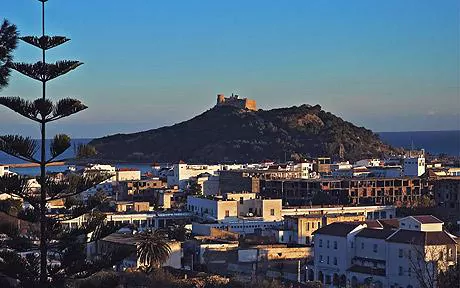Country Tunisia Elevation 15.4 ft (4.7 m) Postal Code 8110 Local time Wednesday 10:45 AM | Governorate Jendouba Governorate Time zone CET (UTC1) Population 17,425 (2014) Number of airports 1 | |
 | ||
Weather 18°C, Wind W at 21 km/h, 59% Humidity | ||
Tabarka (Arabic: طبرقة ṭbarqa, Phoenician Ṭabarqa, Thabraca in Latin, also called Tbarga by locals) is a coastal town located in north-western Tunisia, at about 36°57′16″N 8°45′29″E, close to the border with Algeria. It has been famous for its coral fishing, the Coralis Festival of underwater photography and the annual jazz festival. Tabarka's history is a colorful mosaic of Phoenician, Roman, Arabic and Turkish civilizations. The town is dominated by an offshore rock on which is built a Genoese castle. Nationalist leader Habib Bourguiba, later to become president of post-independence Tunisia, was exiled here by the French colonial authorities in 1952.
Contents
- Map of Tabarka Tunisia
- Maison de la mer tabarka tabarka tunisia hd review
- History
- Ecclesiastical history
- Climate
- Transport
- References
Map of Tabarka, Tunisia
Maison de la mer tabarka tabarka tunisia hd review
History
Although older sources placed Thabraca within the Roman province of Numidia, recent ones agree in placing it in the Roman province of Africa, known also as Africa Proconsularis. It was a Roman colony. It was connected by a road with Simitthu, which it served as a port for the export of its famous marble. At Thabraca the rebellious Roman official Gildo, the brother of Firmus, committed suicide. Under the Vandal king Gaiseric it had a monastery for men and a convent for women.
From 1540 to 1742, the Genoese maintained a garrison on an island, also called Tabarka, which lies about 365 yards off the town. In 1540 the island was given by the Ottoman Bey of Tunis as a concession to the Genoese family of Lomellini. The Genoese were in the service of Spain during 1553 at the request of Emperor Charles V who was interested in coral fishing. The Lomellini were part of the circle of Andrea Doria, Doge of Genoa and were related to parental ties to the Grimaldi family. The grant was possibly due to a secret ransom for the release of the pirate Turkish Dragut, captured in 1540 by Giannettino Doria, nephew of Andrea Doria. The Lomellini colonized Tabarca with a group of inhabitants of Pegli, near Genoa, where they had various properties and a huge palace. The community of Pegliesi lived in Tabarka for several centuries.
In 1738 due to the exhaustion of the coral reefs and the deterioration of relations with the Arab population a large group of 'Tabarchini' moved to San Pietro Island off Sardinia, then uninhabited, where they founded a new town of Carloforte. The transfer was made possible thanks to the King of Sardinia, Charles Emmanuel III of Sardinia who wanted to colonize those of his lands which were not yet inhabited. The name of Carloforte was chosen in honor of the sovereign. Another group of Tabarchini was resettled in the town of Calasetta on the adjacent Island of Sant'Antioco, whose population still speaks a variant of Genoese dialect originating from Tabarka. Others were moved to the Spanish island of New Tabarca. In 1741 the Genoese fortress surrendered to the (nominally Ottoman, de facto autonomous) Bey of Tunis. At Tabarka, the ruins consists of a pit once used as a church and some fragments of walls which belonged to Christian buildings. There were also two Ottoman Turkish fortresses, one of which has been repaired.
Under French colonial rule it was annexed to the civil district of Souk el-Arba, now in the Tunisian governorate of Jendouba, and a rather important fishing centre. Tabarka Jazz Festival was established in 1973.
Ecclesiastical history
Thabraca became a Christian bishopric that is no longer a residential see but is included in the Catholic Church's list of titular sees.
Thabraca was also the seat of an ancient Bishopric and in antiquity it had a monastery for men and one for women, and several church Buildings and Christian cemeteries have been uncovered. The city contains several Christian cemeteries, many of the tombs covered with curious mosaics. An inscription (C.I.L., VIII, 173-82) mentions the cult of the martyr Anastasia and her companions.
Bishops
The bishops of Thabraca, who met with the other bishops of Proconsular Africa, included:
The Bishopric was founded during the Roman Empire and survived through the arian Vandal and Orthodox Byzantine empires, only ceasing to function with the Muslim conquest of the Maghreb. The diocese was re-founded in name at least in the 20th century as a titular see of the Roman Catholic church.
Titular bishops
Climate
The weather in Tabarka is usually unstable depending on the year. Summer is mostly mild and dry since it barely rains in July and August. The average temperatures for this season is 28.2 °C (82.8 °F). As for winter, it is mostly rainy and cold. Some snow can be seen during this time of the year. The average temperature for this season is 7.4 °C (45.3 °F).
Transport
The airport in Tabarka was named Airport 7 Novembre until the Tunisian revolution; it was then renamed Tabarka-Ain Draham International Airport.
